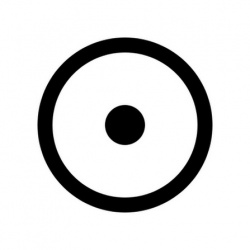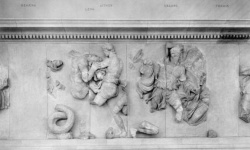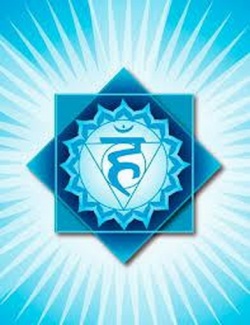Aether as an element
The esoteric sign of the Sun. Aether is generally depicted as a circle, and the Sun, being among the planets the one most associated with the spirit and it’s progression, is considered the greatest of the heavenly Quintessence.
Western occult practises general accept the idea of five elements: the traditional four ensemble, and a fifth, above the physical earth, fire, air and water. This element, generally reffered as Spirit, Quintessence, Akasha or Aether, is interpreted to be “divine” unlike the cruder four, and nowadays invisioned as a cosmic glue, as a force that goes through all things and that drives the will of magick. Basically, it simply symbolises the supernatural, hollistic in involving everything in existence.
Suffice to say, historical perceptions appeared to have been rather distinct. Statue remains, among them the god Aither fighting a lion-like abomination.
Aether, or Aither, is a concept most famously presented in Ancient Greek religion. Αἰθήρ seems to have started as a term for light, being related to αἴθω, a verb generally used in the context of burning or incenerating things. At some point, it seems to have been widely used as a term for Air; Empedocles uses Αἰθήρ to describe normal air, and indeed in his example of “air roots” we have “brilliance”, “heaven”, “eyes”, “beam”, “ray” Eventually, there was a seperation of Aither and Aer; the latter became the concept of normal air, while the former was reserved for the upper air the gods breathed.
In this new meaning, Aither became personified as a protogenoi deity, the primordial source of light that illumines the day. Normal air became embodied by Khaos, the protogenoi of the protogenoi, from which all spanned; Aither is her grandson, and another type of air, Erebos, is her child. Erebos came to represent the infernal chthonic air, the shadowy antithesis of Aither. This renders the modern notions of Spirit/Akasha being represented by the colour black rather ironic.
Aither, as basically the element of the heavens, not only featured promeniently in many theogonies, but was similar considered the source of Zeus’ power, as implicated in the fifth orphic hymn. In this same hymn it is also called “the best element” and “the life spark of all creatures”, implying a role in the traditional greek notion of the soul’s formation. A similar concept is found in the concept of Silla in Inuit cosmology: it too is a “divine air” that personifies heavenly light, and is breathed by all things, granting them life – though a key part in it’s depiction is it’s ammorality, as it tries to regain parts of itself, often by murder.
Aristotle is credited for changing this notion of “sacred air/light” into a distinct element: instead of being the source of light and the air the gods breathe, his notion of Aether also the material from which the heavenly spheres are made. Aristotle followed the division of the terrestrial elements into the “wet/dry” and “cold/hot” axis, and he considered Aether to be neither hot, dry, wet or cold, as he considered the planets to be unchanging, simply changing places and nothing else. In his descriptions, Aether cannot move in a contrary or unnatural motion, and is by nature circular, the planets being circular in shape and moving in circular orbits.
Medieval alchemists would continue this tradition of Aether being the component of heavenly bodies; under the name of Quintessence, it was most exalted as the material that made up the stars. Alchemy as a whole relied on the notion that Quintessence was God’s seed on earth, with all things containing small quantities of it – this is the reason why astrological correspondences exist and work, according to alchemists, with the purer heavenly planets influencing the Quintessence on Earth. This seems to be the first example of Aether as a hollistic element, no longer confined to Heaven, but now present in all earthly things. This, of course, also renders occult operation possible, though in alchemy’s case to refined matter or the self into a heavenly substance.
Alchemical notions of Quintessence also offer a particularly strong association with metal, as the individual metals are considered to be solidified Quintessence formed from the planets’ light. Gold, for example, is considered to be sunlight encased in the earth, copper to be Venus’ light also solidified, and so forth.
Another view of Aether also arose in Classical Greece, however. While Aether is still considered more divine than the other elements in his writtings, Ptolemy treats Aether in a way more comparable to that of the other elements, assigning to it a god and planet (Hermes/Mercury), a stage of existence (death) and a direction (up). Like in Aristotle’s version, this one is outside of the wet/dry and cold/hot axis, and is associated with circular motion.
Vedic Views
Picture of the Vishudha chakra, associated with the concept of “Akasha”.
The other main source for the modern concept of Aether is Akasha/Akasa, a concept found in vedic religions. Akasha seems to be derived from a word for “space”, though it is also used for “sky”, implying origins similar to Aether as the upper luminous air. Another Vedic concept, Prakasa, is blatantly considered to be heavenly light, and seems to be derived from Akasha etymologically.
In hindu traditions, Akasha and Prakasa are held to be distinct concepts, yet very similar. The former is often described as a fluid, as a heavenly nectar that descends into the Vishudha chakra, purifying consumed food. In latter traditions, it is considered to be sound: Vishudha is associated with the sense of hearing, and thus as it’s element is Akasha„ it became defined as the vibrations that run across matter. In this sense, it quickly acquired a holistic interpretation, as sound is pretty much everywhere, and being the most inaccessible element it obviously would have acquired a strong spiritual meaning.
Prakasa, on the other hand, is still held as light: associated with the Ajna chakra – the third eye – and with the god Shiva, Prakasa is the divine light from which all things were made, and that flows from the gods, illumining the individual with divine visions. Thus, we have not one, but two Aethers, two heavenly, subtle elements, the omnipresent sound and the flowing light. For some reason, perhaps the sake of simplicity, only Akasha has gained mainstream popularity among neopagans, which is rather unfortunate.
In buddhist practises, Akasha/Prakasa become intertwined with the concept of Śūnyatā, or “Void”, being simplified into a single element, a primordial substance from which all came fourth, that still binds the elements. Despiste the name, and that fact that it is associated with the concept of internal emptiness, Śūnyatā/Akasa – known in Japanese Buddhism as Kū orSora, all translated as “Void” – is actually associated with mystical energies such as ki, as well as the asian concept of Heaven. It a way, it possibly represents the closest inspiration for neopagan practises, as it too represents a hollistic, divine energy that creates and binds all things.
Anu seal. Anu, or An, is the god of the Luminous Heaven, and at least technically analogous to the greek Aither.
Little is known about the mesopotanian elemental system, though we do know that it’s cosmology did have elemental realms: the Watery Abyss, Earth, the Sky and the Luminous Heaven, governed by Ea/Enki, Marduk, Enlil and Anu, respectively. The latter seems to bear very obvious similarities to greek Aether, being the luminous abode of the universe where the gods dwell. Anu, the patriarch of the pantheon, “lord of the stars and constellations” and king of the most divine of the realms, certainly does resemble Aither, if in a more proactive role in mythology and worship.
Wu Xing and Bagua
Heaven trigram
Traditional chinese elemental systems have five material elements representing the states of matter, with Earth being considered the Quintessence, as it is both Yin and Yang, and nourishes all things, including the other elements. Metal, however, is still comparably analogous to the western notions of Aether in some aspects: it represents Heaven, particularly in Bagua where the Heaven trigram is attributed to it, encompassing skylight, stars and lightning. Like in Ptolemy’s version, it is also associated with death and the spirit, and it resembles alchemical Quintessence in not only the connection of heavenly light with earthly metals, but also in representing a drive for alchemical refinement and purification. Curiously, buddhist traditions in connecting with the “Void” involve grief, which is Metal’s central emotion.
Conclusion
To me, it seems Aether is pretty much Light, considering it being the appearent main origin for the elements reffered as “Aether” in the West and East. I’m not certain about it’s refferal as cosmic glue or it’s glorification in regards to other elements: there is no “Spirit” element, for Spirit is in all things and elements are distinct phases of being.




